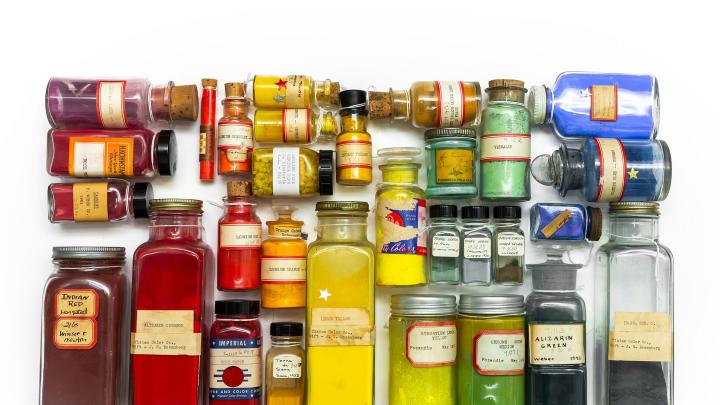The Harvard Art Museums’ world-famous Forbes Pigment Collection, which holds more than 2,700 pigments that have been used in artworks all over the world, is usually inaccessible to visitors. It sits behind glass walls on the fourth floor of the museums’ Renzo Piano-redesigned building, where guests can view it from a distance; the small, bright vials are tightly arranged like scientific specimens in a row of neat gray cabinets. This year, though, visitors can’t enter the building at all, prompting curators and conservators to invent new ways to experience its collections. In “A History of Color: An Audio Tour of the Forbes Pigment Collection,” visitors can peruse 27 pigments chosen from those cabinets, from charcoal, one of the world’s earliest used pigments, to YInMn blue, a bright hue discovered in 2009 that’s highly reflective of infrared radiation.
“We are always having people ask about the pigments,” says Narayan Khandekar, senior conservation scientist and director of the Straus Center for Conservation and Technical Studies, the department of the museums that collects and studies the pigments. “So we have been working on ways of trying to make them more accessible.” The project, which was conceived and mostly finished before the pandemic, was led by Tara Metal, the museums’ digital content manager (“Like so many of our visitors, I’ve long been enchanted by the Forbes Pigment Collection,” she said in a press release).
The colors are accompanied by audio commentary by Khandekar and Alison Cariens, conservation coordinator in the Straus Center, and examples of artworks in which they appear. “I decided to have a choice of animal, mineral, and vegetable pigments and made a grouping of around 30 stories,” Khandekar remembers of the selection process. “Alison chose around 20 pigments based on her experiences of leading lots of tours through the pigments. We both made selections based on our readings, stories that we liked to tell and what people liked to hear.” Other pigments may eventually be added: “There’s more to come,” Khandekar says. “It’s not meant to be a static tour.”
The virtual tour has one major limitation: “When you’re looking at the pigments, you’re not seeing the true color, because it’s mediated through a screen,” Khandekar says. The collection is remarkable because of the fine distinctions between each color, which can be fully appreciated only in person. The RGB coloring system used in computers, Khandekar explains, “doesn’t fully capture what it is that your eye sees.”
Egyptian blue, the world’s first known synthetic pigment, was invented around 2200 B.C.E. and was meant to mimic lapis lazuli, the expensive, deep-blue stone found in present-day Afghanistan. Indian yellow, a warm color used in South Asia and later in Europe following British colonization, was said, according to the tour, to be “the product of dried urine of cows fed on mango leaves.” YInMn blue reflects infrared light so efficiently that “if you have a roof that is painted YInMn blue, it would be probably 10 degrees cooler…it can be energy-saving,” Khandekar explains. “Colors always have social connections in one way or another…and it’d be great if YInMn blue was able to one day symbolize that you’re willing to use your resources to expend less energy.”
The pigment collection was started by Edward Forbes, the second director of the Fogg Art Museum. “Forbes really started this idea of understanding the materials and techniques used by artists,” Khandekar says. “It’s grown into its own discipline called technical art history.”

Jars of pigment used by Georgia O’Keeffe, including burnt sienna, indigo, and rose madder
Photograph Courtesy of Sotheby’s
Earlier this year, the Harvard Art Museums, jointly with the Georgia O’Keeffe Museum in New Mexico, added a new set of colors to its collection: 20 jars of pigments frequently used by the twentieth-century artist, each with the name of the color in her handwriting. Materials like pigments “[give] us all these insights into how an artist makes a work of art,” Khandekar explains. “It gives us a sense of O’Keeffe as a working person preparing to make art.” The acquisition joins other holdings that are used to study how specific artists created their work, including supplies used by painters John Singer Sargent, Barnett Newman, and others.
“I saw the pigments just before the auction, and then this pandemic thing happened,” Khandekar adds. “Once the world is able to open back up again, we’ll have opportunities to work with the O’Keeffe Museum to study their paintings with our postdoc scientists, and we can develop various research projects and find out more about how the pigments were used… She’s a great American painter and really deserves this kind of in-depth study.”








